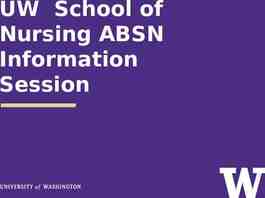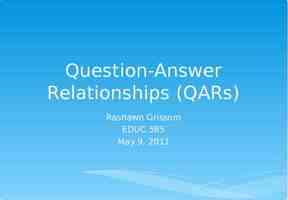Paper 2: Answers
25 Slides65.26 KB

Paper 2: Answers

Approaches 24 marks

Which two of the following statements about the fight or flight response are correct? [2 marks] B and C

Briefly explain one function of the endocrine system. [2 marks] 1 mark for a correct function of the endocrine system To secrete the hormones which are required to regulate many bodily functions To provide a chemical system of communication via the blood stream 1 mark for elaboration of how the function occurs: such as via release of the required amount of a specific hormone to promote appropriate growth or metabolism or reproduction.

Why are the standard deviation values found in the study above useful descriptive statistics for the cognitive psychologist? [2 marks] 2 marks for a clear and coherent explanation of the usefulness of the standard deviation in this study. 1 mark for a weak or muddled answer in which the impact of the difference in the SDs is alluded to. useful to inform about the spread of scores indicates participant variables – as a group the people in Condition 1 are quite different/are more variable than those in Condition 2.

Outline one problem of studying internal mental processes like memory ability by conducting experiments such as that described in Question 03 above. [2 marks] 2 marks for a clear, coherent outline of a relevant problem 1 mark for a weak, muddled or very limited outline Possible problems: Direct observation of memory is not possible and must be inferred from the results/behaviour of the participants – this inference could be mistaken. The task given is rarely how normal memory functioning occurs because it is specifically designed to make measurement possible – the researcher therefore collects data that is only related to memory processing under experimental conditions.

Rita and Holly are identical twins who were separated at birth. When they finally met each other at the age of 35, they were surprised at how different their personalities were. Rita is much more social and out-going than Holly. Use your knowledge of genotype and phenotype to explain this difference in their personalities. [4 marks] Holly and Rita have identical genotype as they are MZ twins. They have the predisposition to develop the same personalities as each other unless another factor(s) intervenes. For them to have developed different personalities over time, this must have been influenced by being in different environments. Their phenotypes – personalities achieved – are different, presumably because Rita was encouraged to be sociable and lively and Holly was not.

Outline and evaluate the social learning theory approach. Refer to evidence in your answer. [12 marks] Learning takes place in a social context Learning occurs via observation of the behaviour of others and the rewards or punishments received for the behaviour Other people act as models and the characteristics of models influence the likelihood of imitation of the behaviour Learning and performance are not the same activity. Mediational processes affect production of behaviour reciprocal determinism and the concept of free will Relevant research eg Bobo doll study, Bandura Concepts of identification and vicarious reinforcement.

Outline and evaluate the social learning theory approach. Refer to evidence in your answer. [12 marks] Possible discussion Use of evidence to support social learning theory Benefits of the experimental approach to investigate learning and issues with experimental evidence that might affect the validity of the results and therefore the conclusions drawn Focus on human traits of consciousness and rationality which cannot be demonstrated with animal research, addresses the influence of mediational processes on learning – neglected by behaviourists Provides explanations that relate to behaviours such as aggression and intellectual development Does not pay much attention to the impact of biological, heredity or maturational factors on behaviour, evidence from these areas of research does show they do have an impact. Credit other relevant information.

Psychopathology 24 marks

What is meant by ‘statistical infrequency’ as a definition of abnormality? [2 marks] 2 marks for a clear and accurate explanation of the term ‘statistical infrequency’ as a definition of abnormality 1 mark for a weak, muddled or very limited explanation Content: A person’s trait, thinking or behaviour would be considered to be an indication of abnormality if it was found to be numerically (statistically) rare/uncommon/anomalous

Outline two characteristics of obsessive-compulsive disorder. Refer to Gavin in your answer. [4 marks] A cognitive characteristic would be an irrational belief or persistent recurring thoughts – catastrophic thinking such as: my family is in danger and might get trapped in a house fire’. An emotional characteristic would be feeling anxiety or the reduction of anxiety such as: ‘worry about them’ or ‘feeling calm after making sure a fire cannot start’. A behavioural characteristic would be performing a repetitive action such as: switching plug sockets six times. Credit for two characteristics of OCD, if student offers three, credit the best two.

A psychologist has suggested treating Tommy’s fear of birds using systematic desensitisation. Explain how this procedure could be used to help Tommy overcome his phobia. [4 marks] 1 mark each for applied description of the following aspects of systematic desensitisation: relaxation, hierarchy development, gradual exposure Plus 1 further mark for some elaboration of any of the three aspects Content: Tommy would be taught relaxation techniques he could use when he encounters birds as part of the therapy. Tommy would devise his hierarchy so it reflects his least to most feared bird situation (for example, small picture of a sparrow, then a small bird through a window ) Tommy would then be exposed to birds gradually, ensuring he is relaxed at each stage.

Explain why systematic desensitisation might be more ethical than using flooding to treat Tommy’s phobia. [2 marks] 2 marks for a clear and coherent explanation of the benefits of systematic desensitisation over flooding as a treatment for a phobia for a child 1 mark for a very brief, weak or muddled explanation Possible points: SD is gradual so the anxiety produced in the treatment is limited whereas in flooding the most feared situation is presented immediately which would be too traumatic for a small child. Tommy may not fully understand that consent to flooding would mean immediate exposure to his most feared situation so his consent to systematic desensitisation increases his protection from harm.

Outline and evaluate at least one cognitive approach to explaining depression. [12 marks) Underlying assumption of the cognitive explanation – depression is the result of disturbance in ‘thinking’. Beck’s negative triad – childhood negative schemas develop providing a negative framework for viewing events pessimistically. In adulthood these become biases such as overgeneralisation; magnification; selective perception and absolutist thinking. The negative triad is where people think consistently negatively about the self, the world and the future. Ellis’s ABC model – developed to explain response to negative events – how people react differently to stress and adversity. The model provides the sequence of the process: A – the adversity or event to which there is a reaction; B – the belief or explanation about why the situation occurred; C – the consequence – the feelings and behaviour the belief now causes. In essence the external event is ‘blamed’ for the unhappiness being experienced. Both models explain depression as a consequence of faulty and negative thinking about events and suggest it can be managed by challenging this faulty thinking. Evidence to support either model such as Beck 1976.

Outline and evaluate at least one cognitive approach to explaining depression. [12 marks) Possible evaluation: The use of examples to illustrate the negative triad or the ABC model The use of evidence to support cognitive explanation(s) The development of successful therapies based on cognitive explanations: CBT and/or REBT Cognitive explanation(s) do not explain the links between anger and depression well Cognitive explanations do not distinguish cause and effect factors Cognitive explanations do not deal with the manic phases in bipolar I and II Comparison with alternative explanations eg biological evidence suggests genetic, neurochemical and neuroanatomical influences a biological predisposition

Research Methods

Use the graph paper below to sketch a display of the data given in Table 2 opposite. You do not need to give your display a title. [3 marks] 3 marks for the following points: Axes correctly labelled as Age of participant and Attitude to social care rating Scales are suitable Points plotted accurately.

What does the display you have drawn in your answer in Question 12.1 suggest about the relationship between age and attitude to social care issues? Explain your answer. [2 marks] 2 marks for: there is a positive relationship between age and interest in social care issues/as people get older their interest in social care increases (1) this is because as the values on one co-variable increase, so do the values on the other co-variable (1) OR as age increases so does attitude to social care rating/score.

Briefly explain how investigator effects might have occurred in this study. [2 marks] 1 mark for knowledge of an investigator effect – this is when the person collecting the data has knowledge of what the research aim is/traits and that knowledge/those traits affect the data obtained. 1 mark for a brief explanation of how investigator effects might have occurred in this study. If the researchers believed that older people would be more interested in social care they could have just given scores based on the age of the person.

Outline how the researchers could have avoided investigator effects having an impact on the study. [2 marks] 2 marks for explaining how investigator effects could have been avoided in the study. The answer needs to explain what could be done and how that would decrease/eliminate the effect. Possible content: Discussion of separate observation by the two researchers and comparison – inter-rater reliability Having ‘blind’ rating of the discussion by someone who is unaware of the aim or research hypothesis Filming the discussions so there is a permanent record that can be checked by peer review of the data to confirm the scores/ratings.

Briefly discuss the benefits for the researcher of using both closed and open questions on their questionnaire about attitudes to social care. [4 marks] Closed questions would present participants with options for their response so the researchers would be able to collate and display the information collected easily. Closed questions make it easy to compare specific response to questions the researchers wanted answered – they can be sure there will be certain information because they have restricted the options to include that information. Open questions allow respondents to interpret the question as they wish to and develop their response with detail or depth – so there is lots of information received. Open questions allow the researchers to pursue a line of enquiry that they may not have predicted but which comes to light because of a response by an interviewee.

Write one question that you think the researchers might have put on their questionnaire. Explain which type of question you have written and why you think this would be a suitable question for this study. [3 marks] 1 mark for an appropriate open or closed question – requiring information about a social care issue 1 mark for correct identification of this as an open or closed type of question 1 mark for a suitable explanation for why the choice was appropriate – this could relate to producing a type of data (closed – ease of analysis, open – lots of detail or depth to response/allows respondent to elaborate her/his reasoning for the response given) or it could focus on an issue of social care introduced by the candidate and not in the stem.

The researchers have obtained both qualitative and quantitative data in the observations and interviews they have conducted. Identify the qualitative and quantitative data collected in this study. Explain your answer. (4 marks) 1 mark: the responses to the open questions in the interview constitute qualitative data Plus 1 mark: the attitudes ratings AND/OR the collated responses to the closed questions in the interview constitute quantitative data 1 mark for an explanation of how the responses to the open questions is qualitative data ie is nonnumeric/descriptive/retains detail of actions/thoughts/feelings Plus 1 mark for an explanation of how the ratings/collated responses to closed questions is quantitative data ie numerical such as a score/behaviour is represented in the form of a score on a scale

Explain how the researchers should have addressed two ethical issues in the investigation. [4 marks] 2 marks for each explanation of how the chosen ethical issue could be dealt with. 1 mark for a brief muddled explanation. 2 marks for a clear explanation. Consent – to be part of what is in essence two studies. Participants should be forewarned – a briefing. Protection from harm – at the end of participation all will have to be fully aware that they were rated for their social care interest and a low score might indicate they are ‘uncaring’. They may wish to withdraw their data. Right to withdraw – being made aware that they can at any time stop participating and at the end of their participation they can withdraw detail of their behaviour in the research. The explanation must demonstrate an appreciation that people should be dealt with, with respect and competence. Credit other relevant ethical issues.






